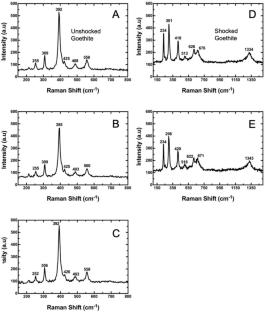Goethite (α-FeOOH) is an iron-oxyhydroxide mineral that is commonly found in soils and is of importance within the context of industrial mineralogy and aqueous geochemistry. The structure of goethite is such that vacant rows of octahedral sites form “channels” or nanopores. This study aims to investigate the response of goethite to dynamic shock compression in order to advance our understanding of minerals as potential shock-absorbing media. Shock compression of synthetic goethite powdered samples was achieved by using an inverted shock microscope and laser driven “flyer plates”. With this setup, a high-energy laser launches small aluminum discs as projectiles or flyer plates at velocities of the order of a few km/s towards the sample. The resulting impact sends a shock wave through the sample, thereby compressing it. The compression is precisely controlled by the plate-impact speed, which in turn is controlled by laser-power. In this work, 25 µm aluminum flyer plates with 3.5 km/s impact velocities were used. The impact resulted in a planar shock wave with shock velocity (Us) ~ 6.78 km/s and an estimated pressure of ~ 41.6 GPa. The shock wave compressed the target goethite for 5 ns. Subsequent, post-shock investigations via transmission electron microscopy (TEM) documented that crystal morphology persisted, and that goethite’s “bird’s nest” texture was maintained. Lattice fringe images revealed localized zones of distortion and amorphous regions within single goethite particles. Raman spectra appear to indicate structural changes after shock compression with the shocked goethite spectra matching that of synthetic hematite. X-ray diffraction (XRD) interestingly identified two major phases: goethite and magnetite. Irrespective of the mineral phases present, the goethite particles persist post shock. A thixotropic-like model for accompanying shock compression is proposed to account for goethite’s shock resistant behavior.




